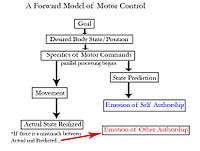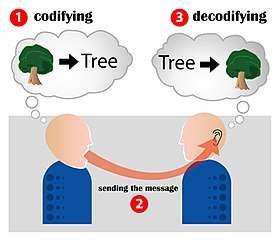Intrapersonal communication
Intrapersonal communication is a communicator's internal use of language or thought. It can be useful to envision intrapersonal communication occurring in the mind of the individual in a model which contains a sender, receiver, and feedback loop.
Definitions
In Communication: The Social Matrix of Psychiatry, Jurgen Ruesch and Gregory Bateson argue that intrapersonal communication is indeed a special case of interpersonal communication, as "dialogue is the foundation for all discourse."
Intrapersonal communication can encompass:
- Speaking aloud as in reading aloud, repeating what one hears, the additional activities of speaking and hearing (in the third case of hearing again) what one thinks, reads or hears. This is considered normal although this does not exactly refer to intrapersonal communication as reading aloud may be a form of rhetorical exercise although expected in the relevant young age.
Mechanisms
Our ability to talk to ourselves and think in words is a major part of the human experience of consciousness. From an early age, individuals are encouraged by society to introspect carefully, but also to communicate the results of that introspection.[1] Simon Jones and Charles Fernyhough cite research suggesting that our ability to talk to ourselves is very similar to regular speech.[2] This theory originates with the developmental psychologist Lev Vygotsky, who observed that children will often narrate their actions out loud before eventually replacing the habit with the adult equivalent: sub-vocal articulation. During sub-vocal articulation, no sound is made but the mouth still moves. Eventually, adults may learn to inhibit their mouth movements, although they still experience the words as "inner speech".[2][3]
Jones and Fernyhough cite other evidence for this hypothesis that inner speech is essentially like any other action. They mention that schizophrenics suffering auditory verbal hallucinations (AVH) need only open their mouths in order to disrupt the voices in their heads. To try and explain more about how inner speech works, but also what goes wrong with AVH patients, Jones and Fernyhough adapt what is known as the "forward model" of motor control, which uses the idea of "efferent copies".[2]

In a forward model of motor control, the mind generates movement unconsciously. While information is sent to the necessary body parts, the mind basically faxes a copy of that same information to other areas of the brain. This "efferent" copy could then be used to make predictions about upcoming movements. If the actual sensations match predictions, we experience the feeling of agency. If there is a mismatch between the body and its predicted position, perhaps due to obstructions or other cognitive disruption, no feeling of agency occurs.[2]
Jones and Fernyhough believe that the forward model might explain AVH and inner speech. Perhaps, if inner speech is a normal action, then the malfunction in schizophrenic patients is not the fact that actions (i.e. voices) are occurring at all. Instead, it may be that they are experiencing normal, inner speech, but the generation of the predictive efferent copy is malfunctioning. Without an efferent copy, motor commands are judged as alien (i.e. one does not feel like they caused the action). This could also explain why an open mouth stops the experience of alien voices: When the patient opens their mouth, the inner speech motor movements are not planned in the first place.[2]
Evolved to avoid silence
Joseph Jordania suggested that talking to oneself can be used to avoid silence. According to him, the ancestors of humans, like many other social animals, used contact calls to maintain constant contact with the members of the group,[4] and a signal of danger was communicated through becoming silent and freezing.[5] Because of the human evolutionary history, prolonged silence is perceived as a sign of danger and triggers a feeling of uneasiness and fear. According to Jordania, talking to oneself is only one of the ways to fill in prolonged gaps of silence in humans. Other ways of filling in prolonged silence are humming, whistling, finger drumming, or having TV, radio or music on all the time.
Intrapersonal communication and personal pronouns
Intrapersonal communication can be facilitated through both first person and second person pronouns. However, through years of research, scholars have already realized that people tend to use first-person and second-person self-talk in different situations. Generally speaking, people are more likely to use the second-person pronoun referring to the self when there is a need for self-regulation, an imperative to overcome difficulties, and facilitation of hard actions [6][7] whereas first person intrapersonal talks are more frequently used when people are talking to themselves about their feelings.[8]
Recent research also has revealed that using the second-person pronoun to provide self-suggestion is more effective in promoting the intentions to carry out behaviors and performances.[9] The rationale behind this process lies in the idea of classical conditioning, a habit theory which argues that repetition of a stable behavior across consistent contexts can strongly reinforce the association between the specific behavior and the context. Building on such rationale, forming internal conversations using second-person pronouns can naturally reproduce the effect of previous encouragement or positive comments from others, as people have already gotten used to living under second-person instructions and encouragements in their childhood. This self-stimulated encouragement and appraisals from previous experience could also generate positive attitudes, intentions, and behaviors.
Criticism of the concept
In 1992, a chapter in Communication Yearbook #15, argued that "intrapersonal communication" is a flawed concept. The chapter first itemized the various definitions. Intrapersonal communication, it appears, arises from a series of logical and linguistic improprieties. The descriptor itself, 'intrapersonal communication' is ambiguous: many definitions appear to be circular since they borrow, apply and thereby distort conceptual features (e.g., sender, receiver, message, dialogue) drawn from normal inter-person communication; unknown entities or person-parts allegedly conduct the 'intrapersonal' exchange; in many cases, a very private language is posited which, upon analysis, turns out to be totally inaccessible and ultimately indefensible. In general, intrapersonal communication appears to arise from the tendency to interpret the inner mental processes that precede and accompany our communicative behaviors as if they too were yet another kind of communication process. The overall point is that this reconstruction of our inner mental processes in the language and idioms of everyday public conversation is highly questionable, tenuous at best.[10]
See also
References
- ↑ Schlinger, H. D. (2009). Some clarifications on the role of inner speech in consciousness. Consciousness and Cognition (18), 530-531.
- 1 2 3 4 5 Jones, S. R., & Fernyhoug, C. (2007). Thought as action: Inner speech, self-monitoring, and auditory verbal hallucinations. Consciousness and Cognition, 16, 391-399.
- ↑ Seal, M. L., Aleman, A., & McGuire, P. K. (2004). Compelling imagery, unanticipated speech and deceptive memory: Neurocognitive models of auditory verbal hallucinations in schizophrenia. Cognitive Neuropsychiatry, 9, 43–72.
- ↑ Macedonia, J. (1986). "Individuality in the contact call of the ring-tailed lemur (Lemur catta)". American Journal of Primatology, 11, 163-179
- ↑ Jordania, J. (2009). "Times to Fight and Times to Relax: Singing and Humming at the Beginnings of Human Evolutionary History". Kadmos, 1, 272–277
- ↑ Gammage, K. L., Hardy, J., & Hall, C. G. (2001). A description of self-talk in exercise. Psychology of Sport and Exercise, 2, 233–247
- ↑ Zell, E., Warriner, A. B., & Albarracín, D. (2012). Splitting of the mind: When the You I talk to is Me and needs commands. Social Psychological and Personality Science, 3, 549–555
- ↑ Oliver, E. J., Markland, D., Hardy, J., & Petherick, C. M. (2008). The effects of autonomy-supportive versus controlling environments on self-talk. Motivation & Emotion, 32, 200–212.
- ↑ Dolcos, S. & Albarracin, D. (2014). The inner speech of behavioral regulation: Intentions and task performance strengthen when you talk to yourself as a You. European Journal of Social Psychology
- ↑ Cunningham, Stanley B. (1992). "Intrapersonal Communication: A Review and Critique," Communication Yearbook #15, (Newbury Park, CA: Sage Publications), pp. 597-620.
